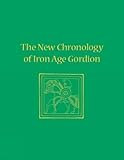The New Chronology of Iron Age Gordion / ed. by Gareth Darbyshire, C. Brian Rose.
Material type: TextPublisher: Philadelphia : University of Pennsylvania Press, [2012]Copyright date: ©2012Description: 1 online resource (200 p.) : 120 illusContent type:
TextPublisher: Philadelphia : University of Pennsylvania Press, [2012]Copyright date: ©2012Description: 1 online resource (200 p.) : 120 illusContent type: - 9781934536445
- 9781934536551
- online - DeGruyter
- Issued also in print.
| Item type | Current library | Call number | URL | Status | Notes | Barcode | |
|---|---|---|---|---|---|---|---|
 eBook
eBook
|
Biblioteca "Angelicum" Pont. Univ. S.Tommaso d'Aquino Nuvola online | online - DeGruyter (Browse shelf(Opens below)) | Online access | Not for loan (Accesso limitato) | Accesso per gli utenti autorizzati / Access for authorized users | (dgr)9781934536551 |
Frontmatter -- Contents -- Illustrations -- Tables -- Acknowledgments -- Introduction -- 1. The Creation of the Old Chronology -- 2. Emerging Problems and Doubts -- 3. Textual Evidence and the Destruction Level -- 4. Artifacts -- 5. Dendrochronology at Gordion -- 6. Radiocarbon Dating Iron Age Gordion, and the Early Phrygian Destruction in Particular -- 7. In Conclusion -- Turkish Summary/Özet -- Contributors -- Index
restricted access online access with authorization star
http://purl.org/coar/access_right/c_16ec
The New Chronology of Iron Age Gordion argues that the history and archaeology of the site of Gordion, in central Turkey, have been misunderstood since the beginning of its excavation in the 1950s. The first excavation director, Rodney Young, found evidence for substantial destruction during the first decade of fieldwork; this was interpreted as proof that Gordion had been destroyed ca. 700 B.C. by the Kimmerians, a group of invaders from the Caucusus/Black Sea region, as attested in several ancient literary sources. During the last decade, however, renewed research on the archaeological evidence, within, above, and below the destruction level indicated that the catastrophe that destroyed much of Gordion occurred 100 years earlier, in 800 B.C., and was the result of a fire that quickly got out of control rather than a foreign invasion.This discovery requires a reassessment of Anatolian history during the entire first millennium B.C. and has serious implications for our understanding of the surrounding regions, such as Assyria, Syria, Greece, and Urartu, among others. The New Chronology of Iron Age Gordion is the product of a multidisciplinary research program, with dendrochronology and radiocarbon dating working hand in hand with textual and artifact analysis, each of which is treated in a separate chapter in this volume. All of these categories of evidence point to the same conclusion and demonstrate that we need to look at Gordion, and much of the ancient Near East, in a completely new way.University Museum Monograph, 133
Issued also in print.
Mode of access: Internet via World Wide Web.
In English.
Description based on online resource; title from PDF title page (publisher's Web site, viewed 24. Apr 2022)


